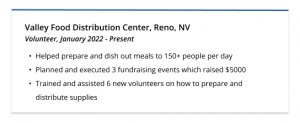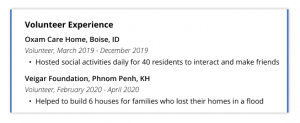

Related Posts
Subscribe to Our Blog
Subscribe to receive email notifications every time we publish new insights, news, and thought leadership to our blog.

Including volunteer work on your resume is a great way to demonstrate to hiring managers that you’re community-focused, and would be a hard-working employee if hired. In fact, the 2016 Deloitte Impact Survey found that 82% of 2500+ hiring managers prefer candidates who have volunteering experience.
But how you present your volunteer work is also a factor in how hiring managers perceive your experiences. In this article, we’re going to show you how to present that volunteer work so you can highlight it like a pro and get more job interviews!
Similar to your work experience section, your volunteer experiences should include the following information (in this order):
Presenting your volunteer experience like a job emphasizes that you take every role, whether paid or unpaid, seriously.
Here’s an example of how to list volunteer experience on a resume:

Keep in mind that like your work experience, you should only include your volunteer experiences if they’re relevant to the job you’re applying for. But if you don’t have much professional experience to put on your resume, you can include your volunteer experience with one bullet point highlighting your most impressive achievement to save space.
Your volunteer experience should go in your experience section or a dedicated volunteer work section. How you format this experience depends on how relevant it is to the job you’re applying for.
But keep in mind that you shouldn’t list your volunteer experience in your hobbies and interests section, because you’d be grouping related work experience with unrelated activities.
List your volunteer experience in your experience section if it’s highly relevant to the job you’re applying for.
Volunteer experience is similar to work experience because both require you to apply for the position and then have someone train you and evaluate your performance. Even meeting new people and building skills are functionally the same, which makes volunteering a great opportunity to prepare for paid work.
You can make your volunteer experience stand out on a resume by using action verbs to start each bullet point and including hard numbers to quantify your notable achievements.
Action verbs help to deliver the desired impact to your physical actions while quantifying your achievements using numbers conveys to the hiring managers how much workload you can handle. Using numbers also emphasizes how you’ve positively influenced the organization, and thus shows how much you’d be able to contribute to their respective organizations.
Here are some examples of effective volunteer experience bullet points:

Additionally, you should list volunteer work in your experience action if you’ve had a long career gap. Filling the spot in your work experience section with relevant volunteer experience helps to convey to hiring managers that even when you’re not working professionally, you still strive to develop new skills and work hard.
If your volunteer experiences aren’t relevant to the job you’re applying for, or you have multiple volunteer experiences, list them in a separate section labeled “Volunteer Experience.”
If you have more volunteer work than professional work, you can format your resume with your dedicated volunteer-work section higher up on the page than your experience section. This type of formatting effectively draws attention away from your lack of paid work while highlighting your more substantial amount of volunteering.
You’d list your volunteer experiences in this section the same way as in your experience section but remember to only include one bullet point to avoid using too much space for unrelated experiences.
Here’s an example of volunteer experience in a dedicated volunteer work section:

These volunteer experiences, though unrelated, will still help convey positive points about your dedication and character to hiring managers.
Keep in mind that you shouldn’t list your volunteer experience in your hobbies and interests section, because you’d be grouping related work experience with unrelated activities.
How you list your volunteer work in your resume is a large factor in how hiring managers will perceive your volunteering experiences. Make sure to impress the 82% of hiring managers by including your experiences in your resume along with highlighting your notable accomplishments and array of skills.
 Chloe Chioy is a Staff Writer and Resume Expert at Resume Genius. Her job advice has been featured on career platforms like Zapier and CharityJob, as well as on the BBC.
Chloe Chioy is a Staff Writer and Resume Expert at Resume Genius. Her job advice has been featured on career platforms like Zapier and CharityJob, as well as on the BBC.
Subscribe to receive email notifications every time we publish new insights, news, and thought leadership to our blog.